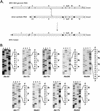Coronavirus particle assembly: primary structure requirements of the membrane protein
- PMID: 9658133
- PMCID: PMC109893
- DOI: 10.1128/JVI.72.8.6838-6850.1998
Coronavirus particle assembly: primary structure requirements of the membrane protein
Abstract
Coronavirus-like particles morphologically similar to normal virions are assembled when genes encoding the viral membrane proteins M and E are coexpressed in eukaryotic cells. Using this envelope assembly assay, we have studied the primary sequence requirements for particle formation of the mouse hepatitis virus (MHV) M protein, the major protein of the coronavirion membrane. Our results show that each of the different domains of the protein is important. Mutations (deletions, insertions, point mutations) in the luminal domain, the transmembrane domains, the amphiphilic domain, or the carboxy-terminal domain had effects on the assembly of M into enveloped particles. Strikingly, the extreme carboxy-terminal residue is crucial. Deletion of this single residue abolished particle assembly almost completely; most substitutions were strongly inhibitory. Site-directed mutations in the carboxy terminus of M were also incorporated into the MHV genome by targeted recombination. The results supported a critical role for this domain of M in viral assembly, although the M carboxy terminus was more tolerant of alteration in the complete virion than in virus-like particles, likely because of the stabilization of virions by additional intermolecular interactions. Interestingly, glycosylation of M appeared not essential for assembly. Mutations in the luminal domain that abolished the normal O glycosylation of the protein or created an N-glycosylated form had no effect. Mutant M proteins unable to form virus-like particles were found to inhibit the budding of assembly-competent M in a concentration-dependent manner. However, assembly-competent M was able to rescue assembly-incompetent M when the latter was present in low amounts. These observations support the existence of interactions between M molecules that are thought to be the driving force in coronavirus envelope assembly.
Figures










References
-
- Arpin N, Talbot P J. Molecular characterization of the 229E strain of human coronavirus. Adv Exp Med Biol. 1990;276:73–80. - PubMed
Publication types
MeSH terms
Substances
Grants and funding
LinkOut - more resources
Full Text Sources
Other Literature Sources

